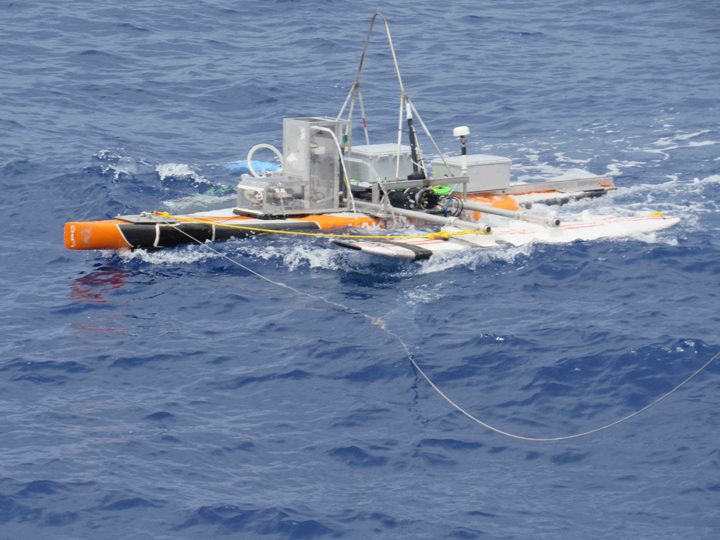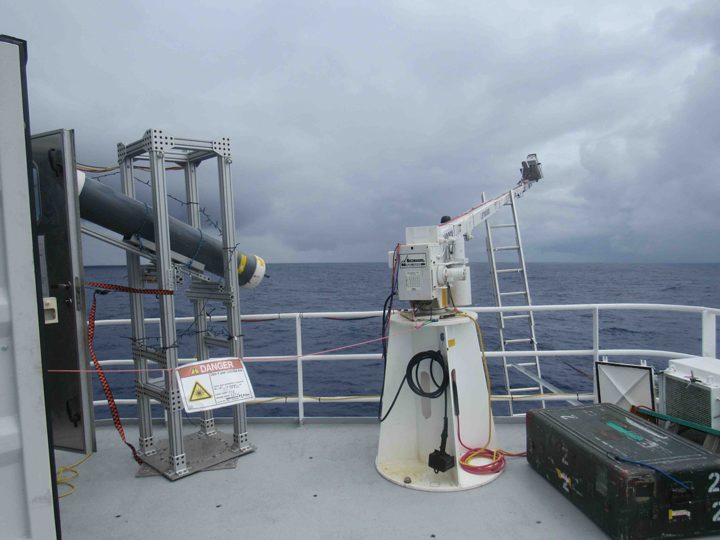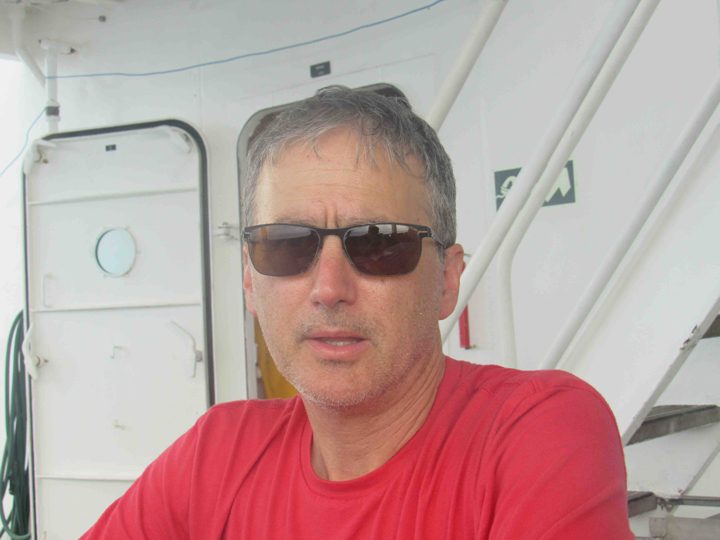One of the key pieces of the puzzle we seek to solve in SPURS relates to turbulence. We really need a deeper knowledge of how turbulence near the ocean surface mixes the surface waters (See prior blog: What is ocean microstructure and why study it?). Rainfall here freshens the ocean, but mixing from saltier waters below and from north and south make the ocean saltier. So, some of the key observations in SPURS are measures of turbulence. Microstructure measurements on the Surface Salinity Profiler (SSP) provide a direct measure of turbulent mixing in the upper meter of the ocean (See prior blog: Chasing the Elusive Surface Salinity Profile).

Surface Salinity Profiler.
Cunningly, the APL team is using another indirect measure of turbulence to simultaneously support and enhance interpretation of the SSP measurements. The Controlled Flux Technique (CFT) is simple in concept and provides a good qualitative measure of the increases and decreases of mixing at the ocean surface as we tow the SSP.
The CFT concept is to shoot a high power laser pulse at the ocean surface, heating the surface instantly by about 3C. An infrared camera (sensitive to temperature variations) photographs the spot where the laser hit the surface and using 25 snapshots per second tracks the cooling of the patch back to normal over the course of about one second. The speed at which the temperature returns to normal is a very good estimate of the amount of turbulent mixing at the surface. More turbulence means a fast decay to ambient temperature. Just the qualitative knowledge of the ups and downs of turbulence provided by CFT method is an enormous help in interpreting the SSP turbulence data.

Laser (left) and infrared imager.
The laser in use is big and powerful, a 125Watt CO2 laser that shoots 100 millisecond pulses of 10.6 micron (wavelength) light at the surface. The laser light cannot penetrate water or flesh but its purpose is to quickly raise the temperature of the surface of the ocean which means that it can also burn a person or ignite a sheet of paper. Scientists can locate the beam by waving a two by four in the air. When the laser beam hits the wood there is a puff of smoke and a burst of flame. Ah!! There is the beam! We are all safe on the ship because the laser is pointed out away from the ship. The infrared laser beam is almost totally absorbed by the seawater so there is no danger of reflection.

Three scars of laser pulses on a two-by-four.
The camera imaging the sea surface generates large volumes of data – about 1 Gigabyte per minute of use and we are sometimes making 10 hour runs every day! Bill Asher from UW Applied Physics Lab is running the CFT experiment and has brought petabytes of data storage. Interpretation back home will keep his desktop computer grinding for months!

Bill Asher explains the Controlled Flux Technique.
Lucky for us we have a data processing mascot aboard the trip to assist Bill and other SPURS-2 scientists. Ootori-sama is a kind spirit duck whose “water karma” will assure good luck in all water-related data processing. Its is fun for us to inject some humor and superstition into shipboard life (See prior blog: Hello, Knorr? It’s The International Space Station Calling) especially around Halloween!

Ootori-sama working on CFT data processing.
The science to come out of the CFT analysis and the SSP in SPURS-2 is pretty simple. Conventional wisdom holds that rain INCREASES turbulence at the ocean surface. Last year’s work with CFT and SSP hints at the contrary idea – that rainfall may reduce wave micro-breaking at the ocean surface an REDUCE turbulent mixing. Fresh water tends to stabilize the ocean surface because the fresh water is more buoyant than salt water – but it also seems to have additional ways and means to reduce turbulence. Knowing these facts is key to modeling upper ocean salinity and interpreting the salinity measurements from space. How fresh water mixes into the ocean via rainfall is essential information for understanding the water cycle on the planet.
Tags: ocean salinity, oceanography, SPURS, SPURS2



